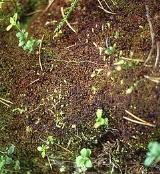
Jungermanniaceae
Encyclopedia
Jungermanniaceae is the namesake family
of leafy liverworts
. It is a group of small plants that are widely distributed. Several genera formerly included within the family are now classified in the Myliaceae
or Solenostomataceae
.
Most of the species
of this family are found in temperate
regions.
The main characteristics of the family:
1. The leaves are succubous
.
2. The leaves are unlobed and never decurrent along the stem.
3. Perianth
is terminal on the leading shoot.
4. Rhizoid
s are scattered along the stem.
s are scattered along the underside of the stem, and not restricted to specific patches near the underleaves.
Family (biology)
In biological classification, family is* a taxonomic rank. Other well-known ranks are life, domain, kingdom, phylum, class, order, genus, and species, with family fitting between order and genus. As for the other well-known ranks, there is the option of an immediately lower rank, indicated by the...
of leafy liverworts
Jungermanniales
Jungermanniales is the largest order of liverworts. They are distinctive among the liverworts for having thin leaf-like flaps on either side of the stem...
. It is a group of small plants that are widely distributed. Several genera formerly included within the family are now classified in the Myliaceae
Myliaceae
Myliaceae is a family of liverworts in order Jungermanniales. While many species are green, some species may be brownish to reddish. The leaves are unlobed and have a smooth edge; the underleaves are tapered and narrow. Plants may have gemmae....
or Solenostomataceae
Solenostomataceae
Solenostomataceae is a family of liverworts in order Jungermanniales....
.
Most of the species
Species
In biology, a species is one of the basic units of biological classification and a taxonomic rank. A species is often defined as a group of organisms capable of interbreeding and producing fertile offspring. While in many cases this definition is adequate, more precise or differing measures are...
of this family are found in temperate
Temperate
In geography, temperate or tepid latitudes of the globe lie between the tropics and the polar circles. The changes in these regions between summer and winter are generally relatively moderate, rather than extreme hot or cold...
regions.
The main characteristics of the family:
1. The leaves are succubous
Succubous
The term succubous is used to describe the way in which the leaves of a plant are attached to the stem. If you were to look down from above on a plant where the leaf attachment is succubous, the lower edge of each leaf would overlap the next lower leaf along the stem...
.
2. The leaves are unlobed and never decurrent along the stem.
3. Perianth
Perianth
The term perianth has two similar but separate meanings in botany:* In flowering plants, the perianth are the outer, sterile whorls of a flower...
is terminal on the leading shoot.
4. Rhizoid
Rhizoid
Rhizoids are thread-like growths from the base or bottom of a plant, found mainly in lower groups such as algae, fungi, bryophytes and pteridophytes, that function like roots of higher plants ....
s are scattered along the stem.
Family Description
When the plants branch, the branches do not grow from the underside of the stem. The leaves are unlobed and have a smooth edge, and the underlobes are vestigial or absent. The rhizoidRhizoid
Rhizoids are thread-like growths from the base or bottom of a plant, found mainly in lower groups such as algae, fungi, bryophytes and pteridophytes, that function like roots of higher plants ....
s are scattered along the underside of the stem, and not restricted to specific patches near the underleaves.

